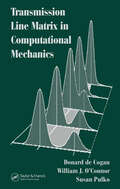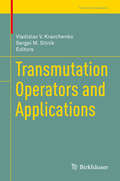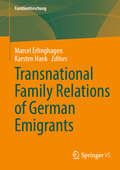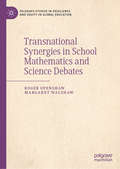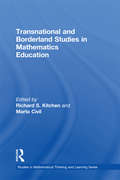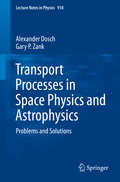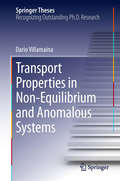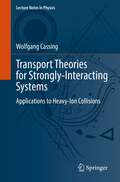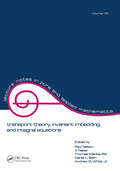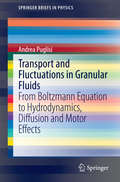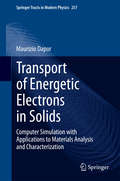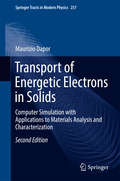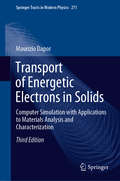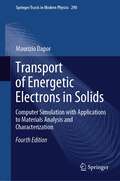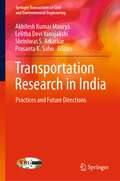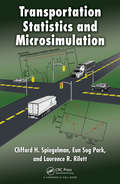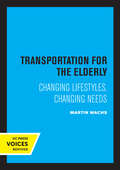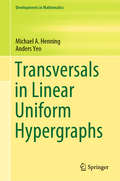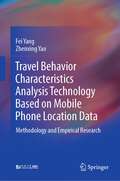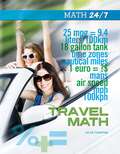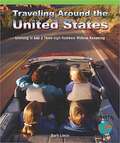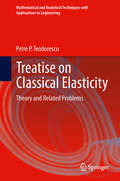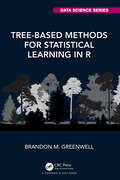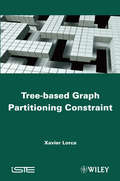- Table View
- List View
Transmission Line Matrix (TLM) in Computational Mechanics
by Donard de Cogan William J. O'Connor Susan PulkoThe finite element method reigns as the dominant technique for modeling mechanical systems. Originally developed to model electromagnetic systems, the Transmission Line Matrix (TLM) method proves to match, and in some cases exceed, the effectiveness of finite elements for modeling several types of physical systems. Transmission Line Matrix in Compu
Transmutation Operators and Applications (Trends in Mathematics)
by Vladislav V. Kravchenko Sergei M. SitnikTransmutation operators in differential equations and spectral theory can be used to reveal the relations between different problems, and often make it possible to transform difficult problems into easier ones. Accordingly, they represent an important mathematical tool in the theory of inverse and scattering problems, of ordinary and partial differential equations, integral transforms and equations, special functions, harmonic analysis, potential theory, and generalized analytic functions. This volume explores recent advances in the construction and applications of transmutation operators, while also sharing some interesting historical notes on the subject.
Transnational Family Relations of German Emigrants (Familienforschung)
by Karsten Hank Marcel ErlinghagenDrawing on unique data from the German Emigration and Remigration Panel Study (GERPS), the present book comprises empirical studies on various aspects of recent German emigrants’ transnational relationships to core family members, specifically intimate partners, parents, and children. Moreover, we reflect on conceptual and empirical challenges in previous work on transnational family relations, suggesting avenues for future research. We thereby aim to strengthen the integration of two closely related strands of social research – the sociologies of migration and families – and add an important new facet to the study of transnational families more generally.
Transnational Synergies in School Mathematics and Science Debates (Palgrave Studies in Excellence and Equity in Global Education)
by Margaret Walshaw Roger OpenshawThis book highlights and interrogates the continued interest and scrutiny of mathematics and science education. National debates on excellence and equity tend to focus largely on underachievement in mathematics and science rather than subjects in the arts or music: this is due to a belief that these curriculum areas are central to individual workplace success and national development in a competitive economic environment. The authors explore the history of these assumptions, as well as the debates based around claims that student achievement levels in these subjects has fallen. Spanning the United States, New Zealand, Australia and the United Kingdom, the chapters question how such debates are sustained and amplified: how has this perceived ‘crisis’ been articulated and spread across national borders? This comprehensive book will be of interest and value to scholars of mathematics and science education, as well as international education debates.
Transnational and Borderland Studies in Mathematics Education (Studies in Mathematical Thinking and Learning Series)
by Richard S. Kitchen Marta CivilEvery year, significant numbers of immigrant children from Mexico enter classrooms in the United States. These immigrants comprise a heterogeneous group of students with diverse needs, abilities, and experiences. Transnational and Borderland Studies in Mathematics Education is the first collection to offer research studies across these communities. Providing invaluable research on both sending and receiving communities in Mexico and the US, this collection considers the multiple aspects of children’s experiences with mathematics, including curriculum, classroom participation structures, mathematical reasoning and discourse – both in and out of school – and parents’ perceptions and beliefs about mathematics instruction. An important treatment of an insufficiently documented subject, this collection brings together researchers on both sides of the border to foster and support an interest in documenting evidence that will set the stage for future studies in mathematics education.
Transport Processes and Separation Process Principles (International Series in the Physical and Chemical Engineering Sciences)
by Christie Geankoplis Allen Hersel Daniel LepekTransport Processes and Separation Process Principles, Fifth Edition, offers a unified and up-to-date treatment of momentum, heat, and mass transfer and separations processes. This edition–reorganized and modularized for better readability and to align with modern chemical engineering curricula–covers both fundamental principles and practical applications, and is a key resource for chemical engineering students and professionals alike.
Transport Processes in Space Physics and Astrophysics
by Alexander Dosch Gary P. ZankThis is the problems and solution manual for the graduate text with the same title and published as Lecture Notes in Physics Vol 877 which provides the necessary mathematical and physics background to understand the transport of gases, charged particle gases, energetic charged particles, turbulence, and radiation in an astrophysical and space physics context. The very detailed and self-contained problems and solutions will be an essential part of the training of any graduate student wishing to enter and pursuing research in this field.
Transport Properties in Non-Equilibrium and Anomalous Systems
by Dario VillamainaThe study of fluctuations in statistical physics has a long history, and a general theory is well established, connecting fluctuations to response properties of equilibrium systems. Remarkably, this framework fails as soon as some current is flowing across the system, driving it out of equilibrium. The presence of currents is quite common in nature and produces rich phenomena which are far from being included in a general framework. This thesis focuses on this general problem by studying different models such as granular materials and systems exhibiting anomalous diffusion and shows how the generalized response techniques can be successfully used to catch the relevant degrees of freedom that drive the systems out of equilibrium. This study paves the way to the use of the generalized fluctuation relations in an operative way, in order to extract information from a non-equilibrium system and to build the corresponding phenomenological theory.
Transport Theories for Strongly-Interacting Systems: Applications to Heavy-Ion Collisions (Lecture Notes in Physics #989)
by Wolfgang CassingThis book provides an overview on transport theories, focusing on applications and the relativistic off-shell transport theory which are of particular interest for physicists working in the field of relativistic strong-interaction physics, e.g. relativistic or ultra-relativistic heavy-ion collisions or the evolution of the early universe. In this regard, a thorough derivation of the transport equations and a careful analysis of the approximations employed is given. The text is enriched with a multitude of Appendices that partly recall elements of quantum mechanics and field theory or present examples for specific models. Specific exercises are given throughout the chapters. As a basic knowledge the reader should be familiar with quantum mechanics and its principles as well as some basic concepts of the quantum many-body physics and field theory. All chapters close with a short summary and numerical calculations are provided to master and illustrate the subject.
Transport Theory: Invariant Imbedding, and Integral Equations: Proceedings in Honor of G.m. Wing's 65th Birthday
by Paul Nelson V. Faber Thomas A. Manteuffel Daniel L. Seth Andrew B. WhiteThis book includes seminal papers on technical subjects—transport theory, invariant imbedding, and integral equations—presented as contributions to honour George Milt Wing in celebration of his 65th birth anniversary in 1988.
Transport and Fluctuations in Granular Fluids
by Andrea PuglisiThis brief offers a concise presentation of granular fluids from the point of view of non-equilibrium statistical physics. The emphasis is on fluctuations, which can be large in granular fluids due to the small system size (the number of grains is many orders of magnitude smaller than in molecular fluids). Firstly, readers will be introduced to the most intriguing experiments on fluidized granular fluids. Then granular fluid theory, which goes through increasing levels of coarse-graining and emerging collective phenomena, is described. Problems and questions are initially posed at the level of kinetic theory, which describes particle densities in full or reduced phase-space. Some answers become clear through hydrodynamics, which describes the evolution of slowly evolving fields. Granular fluctuating hydrodynamics, which builds a bridge to the most recent results in non-equilibrium statistical mechanics, is also introduced. Further and more interesting answers come when the dynamics of a massive intruder are discussed. Such non-equilibrium stochastic process offers a more precise and compact picture of the features foreseen at the more detailed levels of description. The dynamics of an intruder diffusing in a granular fluid reveal the clearest connection with recent theories on stochastic energetics and stochastic thermodynamics.
Transport of Energetic Electrons in Solids
by Maurizio DaporThis book presents the potential of the Monte Carlo (MC) technique to solve mathematical and physical problems of great complexity. This book focusses on the study of the electron-solid interaction (transport MC) and presents some physical problems related to the transport of hot electrons in solid targets using transport MC. The numerical and theoretical results are validated through a comparison with experimental results. The author also addresses methodological aspects. In particular, systematic comparisons among different calculation schemes are presented. Different expressions for the calculation of cross sections and/or stopping power and different simulation methods are described and discussed.
Transport of Energetic Electrons in Solids
by Maurizio DaporThis new edition describes all the mechanisms of elastic and inelastic scattering of electrons with the atoms of the target as simple as possible. The use of techniques of quantum mechanics is described in detail for the investigation of interaction processes of electrons with matter. It presents the strategies of the Monte Carlo method, as well as numerous comparisons among the results of the simulations and the experimental data available in the literature. New in this edition is the description of the Mermin theory, a comparison between Mermin theory and Drude theory, a discussion about the dispersion laws, and details about the calculation of the phase shifts that are used in the relativistic partial wave expansion method. The role of secondary electrons in proton cancer therapy is discussed in the chapter devoted to applications. In this context, Monte Carlo results about the radial distribution of the energy deposited in PMMA by secondary electrons generated by energetic proton beams are presented.
Transport of Energetic Electrons in Solids: Computer Simulation with Applications to Materials Analysis and Characterization (Springer Tracts in Modern Physics #271)
by Maurizio DaporThis book describes, as simply as possible, the mechanisms of scattering (both elastic and inelastic) of electrons with solid targets (electron–atom, electron–plasmon, and electron–phonon interactions). It also presents the main strategies of the Monte Carlo method, as well as numerous comparisons between simulation results and the experimental data available in the literature. Furthermore it provides readers with all the information they need in order to write their own Monte Carlo code and to compare the obtained results with the many numerical and experimental examples presented throughout the book. An extended and updated third edition of a work published in 2014 (first edition) and in 2017 (second edition) on the application of the Monte Carlo method to the transport of fast electrons in solids, this book includes, as novel topics, the theory of polarized electron beams (i.e. density matrix and spin polarization), the study of elastic scattering by molecules, a classical treatment of the Bethe-Bloch stopping power, a simple derivation of the f- and ps-sum rules, the Vicanek and Urbassek formula for the calculation of the backscattering coefficient, the Wolff theory describing the secondary electron spectra, and fundamental aspects of the interactions between electrons beams and solid targets. Further, it describes a completely analytical approach (the so-called multiple reflection method) for calculating the absorbed, backscattered, and transmitted fractions of electrons from unsupported and supported thin films. It also discusses recent applications of the Monte Carlo method.
Transport of Energetic Electrons in Solids: Computer Simulation with Applications to Materials Analysis and Characterization (Springer Tracts in Modern Physics #290)
by Maurizio DaporThis book describes the computational methods most frequently used to deal with the interaction of charged particles, notably electrons, with condensed matter. Both elastic and inelastic scattering phenomena are discussed, and methods for calculating the relevant cross sections are explained in a rigorous but simple way. It provides readers with all the information they need in order to write their own Monte Carlo code and to simulate the transport of fast particles in condensed matter. Many numerical and experimental examples are presented throughout the book.The updated and extended fourth edition features ab initio methods for calculating dielectric function and energy loss function. Non-relativistic partial wave expansion method for calculating the differential elastic scattering cross section is also included in this new edition. It represents a very useful introduction to the relativistic partial wave expansion method, i.e., to the Mott theory, already discussed in the previous editions of this book. Further details about the effects of spin-polarization on the differential elastic scattering cross section are included in this new edition. The multiple reflection method is extended to the general case of a system composed of a set of layers of different materials and thicknesses. Analytical expressions are provided for calculating the backscattering coefficient of multilayers. New results are presented, notably about Monte Carlo simulations of reflection electron energy loss spectra and of the radial dose deposited along the track of ions impinging on materials.
Transportation Research in India: Practices and Future Directions
by Shriniwas S. Arkatkar Akhilesh Kumar Maurya Lelitha Devi Vanajakshi Prasanta K. SahuThis co-edited book focuses on the state-of-the-art research in transportation in India. Exploring the need for a sustainable transport paradigm in India, this timely book offers solution concepts for mobility and infrastructure challenges faced by local, state, and national transport authorities. The contents provide a holistic understanding of the paradigm, considering several case-studies and study findings from the leading transportation researchers in India. At the same time, it also addresses the pressing transportation related challenges such as road user safety, traffic operation efficiency, economic and social development, non-motorized transport planning, environmental impact mitigation, energy consumption reduction, land-use, equity, freight transport planning, multimodal coordination, access for the diverse range of travellers’ needs, sustainable pavement construction, and emerging vehicle technologies. The existing practices and policies in all the sectors and levels of transport are highlighted in this book with an emphasis on a broader vision for achieving sustainable and inclusive development. The information and data-driven inferences compiled in the book will be useful for practitioners, policymakers, educators, researchers, students, and individual learners.
Transportation Statistics and Microsimulation
by Clifford Spiegelman Eun Sug Park Laurence R. RilettBy discussing statistical concepts in the context of transportation planning and operations, Transportation Statistics and Microsimulation provides the necessary background for making informed transportation-related decisions. It explains the why behind standard methods and uses real-world transportation examples and problems to illustrate key conc
Transportation for the Elderly: Changing Lifestyles, Changing Needs
by Martin WachsThis title is part of UC Press's Voices Revived program, which commemorates University of California Press’s mission to seek out and cultivate the brightest minds and give them voice, reach, and impact. Drawing on a backlist dating to 1893, Voices Revived makes high-quality, peer-reviewed scholarship accessible once again using print-on-demand technology. This title was originally published in 1979.
Transversals in Linear Uniform Hypergraphs (Developments in Mathematics #63)
by Michael A. Henning Anders YeoThis book gives the state-of-the-art on transversals in linear uniform hypergraphs. The notion of transversal is fundamental to hypergraph theory and has been studied extensively. Very few articles have discussed bounds on the transversal number for linear hypergraphs, even though these bounds are integral components in many applications. This book is one of the first to give strong non-trivial bounds on the transversal number for linear hypergraphs. The discussion may lead to further study of those problems which have not been solved completely, and may also inspire the readers to raise new questions and research directions. The book is written with two readerships in mind. The first is the graduate student who may wish to work on open problems in the area or is interested in exploring the field of transversals in hypergraphs. This exposition will go far to familiarize the student with the subject, the research techniques, and the major accomplishments in the field. The photographs included allow the reader to associate faces with several researchers who made important discoveries and contributions to the subject. The second audience is the established researcher in hypergraph theory who will benefit from having easy access to known results and latest developments in the field of transversals in linear hypergraphs.
Travel Behavior Characteristics Analysis Technology Based on Mobile Phone Location Data: Methodology and Empirical Research
by Fei Yang Zhenxing YaoThis book is devoted to the technology and methodology of individual travel behavior analysis and refined travel information extraction. Traditional resident trip surveys are characterized by many shortcomings, such as subjective memory errors, difficulty in organization and high cost. Therefore, in this book, a set of refined extraction and analysis techniques for individual travel activities is proposed. It provides a solid foundation for the optimization and reconstruction of traffic theoretical models, urban traffic planning, management and decision-making. This book helps traffic engineering researchers, traffic engineering technicians and traffic industry managers understand the difficulties and challenges faced by transportation big data. Additionally, it helps them adapt to changes in traffic demand and the technological environment to achieve theoretical innovation and technological reform.
Travel Math (Math 24/7)
by Helen ThompsonWhen you're traveling, there are all sorts of numbers to keep track of. If you're driving, how many gallons of gas will you need for the distance you have to cover? How much will those gallons cost you at the pump? If you're going by plane, you'll need to juggle flight schedules. If your plane is delayed by 3 hours, will you be able to make your next connection? And what about if you travel to another country where they use a different kind of money? Will you be able to figure out how to change the money you brought with you into the currency of the country? Will you be able to set your clock back the right amount when you travel across time zones? Travel Math will help you do all this and more!
Traveling Around The United States: Learning To Add 2 Three-digit Numbers Without Regrouping (Math For The Real World Ser.)
by Barbara M. LindeTraveling Around the United States: Learning to Add 2 Three-digit Numbers Without Regrouping
Treatise on Classical Elasticity: Theory and Related Problems
by Petre P. TeodorescuDeformable solids have a particularly complex character; mathematical modeling is not always simple and often leads to inextricable difficulties of computation. One of the simplest mathematical models and, at the same time, the most used model, is that of the elastic body - especially the linear one. But, notwithstanding its simplicity, even this model of a real body may lead to great difficulties of computation. The practical importance of a work about the theory of elasticity, which is also an introduction to the mechanics of deformable solids, consists of the use of scientific methods of computation in a domain in which simplified methods are still used. This treatise takes into account the consideration made above, with special attention to the theoretical study of the state of strain and stress of a deformable solid. The book draws on the known specialized literature, as well as the original results of the author and his 50+ years experience as Professor of Mechanics and Elasticity at the University of Bucharest. The construction of mathematical models is made by treating geometry and kinematics of deformation, mechanics of stresses and constitutive laws. Elastic, plastic and viscous properties are thus put in evidence and the corresponding theories are developed. Space problems are treated and various particular cases are taken into consideration. New solutions for boundary value problems of finite and infinite domains are given and a general theory of concentrated loads is built. Anisotropic and non-homogeneous bodies are studied as well. Cosserat type bodies are also modeled. The connection with thermal and viscous phenomena will be considered too. Audience: researchers in applied mathematics, mechanical and civil engineering.
Tree-Based Methods for Statistical Learning in R (Chapman & Hall/CRC Data Science Series)
by Brandon M. GreenwellTree-based Methods for Statistical Learning in R provides a thorough introduction to both individual decision tree algorithms (Part I) and ensembles thereof (Part II). Part I of the book brings several different tree algorithms into focus, both conventional and contemporary. Building a strong foundation for how individual decision trees work will help readers better understand tree-based ensembles at a deeper level, which lie at the cutting edge of modern statistical and machine learning methodology. The book follows up most ideas and mathematical concepts with code-based examples in the R statistical language; with an emphasis on using as few external packages as possible. For example, users will be exposed to writing their own random forest and gradient tree boosting functions using simple for loops and basic tree fitting software (like rpart and party/partykit), and more. The core chapters also end with a detailed section on relevant software in both R and other opensource alternatives (e.g., Python, Spark, and Julia), and example usage on real data sets. While the book mostly uses R, it is meant to be equally accessible and useful to non-R programmers. Consumers of this book will have gained a solid foundation (and appreciation) for tree-based methods and how they can be used to solve practical problems and challenges data scientists often face in applied work. Features: Thorough coverage, from the ground up, of tree-based methods (e.g., CART, conditional inference trees, bagging, boosting, and random forests). A companion website containing additional supplementary material and the code to reproduce every example and figure in the book. A companion R package, called treemisc, which contains several data sets and functions used throughout the book (e.g., there’s an implementation of gradient tree boosting with LAD loss that shows how to perform the line search step by updating the terminal node estimates of a fitted rpart tree). Interesting examples that are of practical use; for example, how to construct partial dependence plots from a fitted model in Spark MLlib (using only Spark operations), or post-processing tree ensembles via the LASSO to reduce the number of trees while maintaining, or even improving performance.
Tree-based Graph Partitioning Constraint (Wiley-iste Ser. #571)
by Xavier LorcaCombinatorial problems based on graph partitioning enable us to mathematically represent and model many practical applications. Mission planning and the routing problems occurring in logistics perfectly illustrate two such examples. Nevertheless, these problems are not based on the same partitioning pattern: generally, patterns like cycles, paths, or trees are distinguished. Moreover, the practical applications are often not limited to theoretical problems like the Hamiltonian path problem, or K-node disjoint path problems. Indeed, they usually combine the graph partitioning problem with several restrictions related to the topology of nodes and arcs. The diversity of implied constraints in real-life applications is a practical limit to the resolution of such problems by approaches considering the partitioning problem independently from each additional restriction. This book focuses on constraint satisfaction problems related to tree partitioning problems enriched by several additional constraints that restrict the possible partitions topology. On the one hand, this title focuses on the structural properties of tree partitioning constraints. On the other hand, it is dedicated to the interactions between the tree partitioning problem and classical restrictions (such as precedence relations or incomparability relations between nodes) involved in practical applications. Precisely, Tree-based Graph Partitioning Constraint shows how to globally take into account several restrictions within one single tree partitioning constraint. Another interesting aspect of this book is related to the implementation of such a constraint. In the context of graph-based global constraints, the book illustrates how a fully dynamic management of data structures makes the runtime of filtering algorithms independent of the graph density.
